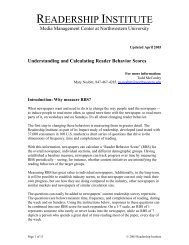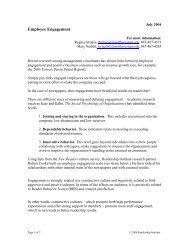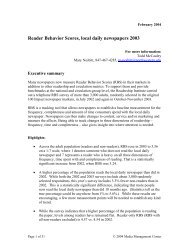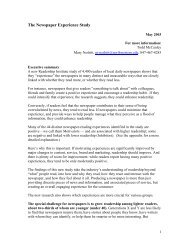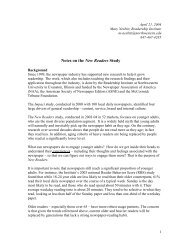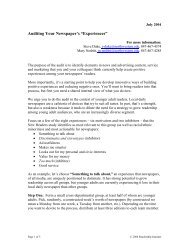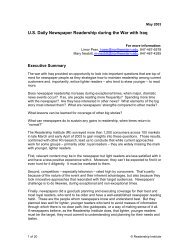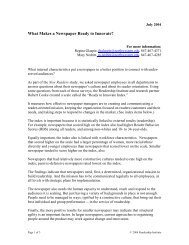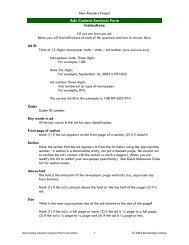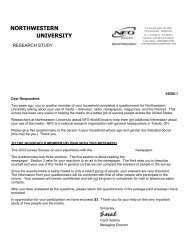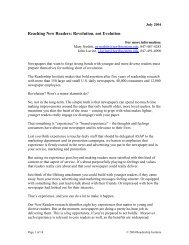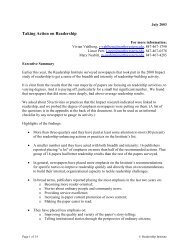Quick Guide to the New Readers culture report - Readership Institute
Quick Guide to the New Readers culture report - Readership Institute
Quick Guide to the New Readers culture report - Readership Institute
Create successful ePaper yourself
Turn your PDF publications into a flip-book with our unique Google optimized e-Paper software.
5. Isn’t it possible <strong>to</strong> be successful with a defensive <strong>culture</strong>? After all, mostnewspapers have this kind of <strong>culture</strong>, and newspapers could hardly be consideredunsuccessful businesses.True. But, <strong>the</strong> question we would ask is, will this <strong>culture</strong> enable newspapers <strong>to</strong> deal withits readership challenges?Consider <strong>the</strong> following facts from <strong>the</strong> research. In both Impact and <strong>New</strong> <strong>Readers</strong> wefound that as constructive norms streng<strong>the</strong>ned, so did readership. We saw thatnewspapers that had stronger constructive norms also tended <strong>to</strong> be more reader-oriented –<strong>the</strong>y were focused on understanding and responding <strong>to</strong> changes in <strong>the</strong>ir market. Theyalso tended <strong>to</strong> have more engaged employees. And constructive <strong>culture</strong>s put a strongemphasis on what <strong>the</strong> organization accomplishes for cus<strong>to</strong>mers, as well as what <strong>the</strong>individual achieves for himself or herself.To explore that last point in more detail, look at <strong>the</strong> material in Tab 4, which is about <strong>the</strong>outcomes or effects of <strong>culture</strong> on individuals and <strong>the</strong> organization. The bar chart on page52 shows <strong>the</strong> areas where newspapers are stronger and weaker than o<strong>the</strong>r organizations.On <strong>the</strong> plus side, <strong>New</strong> <strong>Readers</strong> newspaper employees <strong>report</strong> greater motivation andintention <strong>to</strong> stay and less stress. But a major weakness is inter-unit coordination, followedby job insecurity, poor teamwork and cooperation within <strong>the</strong> work unit, and quality ofservice at <strong>the</strong> organizational level. Three of <strong>the</strong> four significant weaknesses have <strong>to</strong> dowith how well people interact for a common cause.Pages 59-64 show <strong>the</strong> results broken down by department.6. How do we identify practices that can help change <strong>culture</strong>?Tab 5, levers for change, offers some insight in<strong>to</strong> management practices and o<strong>the</strong>r aspectsof work life that that can help alter <strong>culture</strong>. The bar chart on page 69 shows <strong>the</strong> levers onwhich newspapers already perform above average and those on which <strong>the</strong>y are sub-par.You will see <strong>the</strong> latter outnumbers <strong>the</strong> former by about two <strong>to</strong> one.We would suggest focusing on <strong>the</strong> far right of <strong>the</strong> scale, with <strong>the</strong> greatest negative gaps.Look for practices that are related <strong>to</strong> each o<strong>the</strong>r (pages 73-86) and how <strong>the</strong>y cluster in<strong>to</strong>bigger categories. As an example, we note that every item under supervisory/managerialleadership is a large opportunity for improvement: interaction facilitation (which is a longway of saying “coaching”), task facilitation (team-building), goal emphasis andconsideration.Page 4 of 4© 2004 <strong>Readers</strong>hip <strong>Institute</strong>



